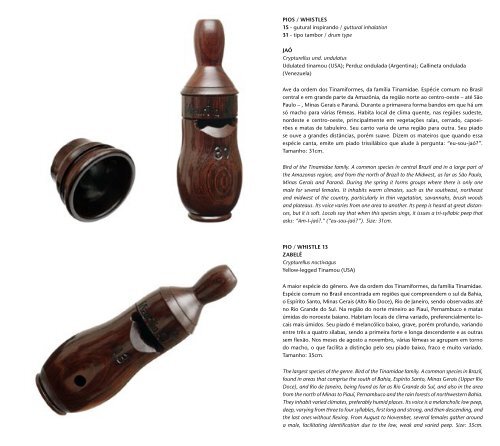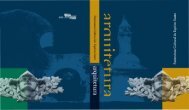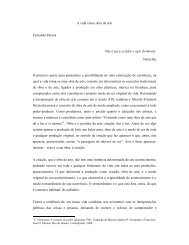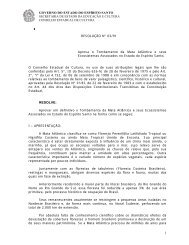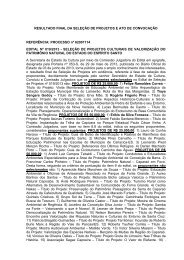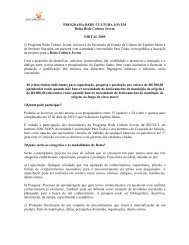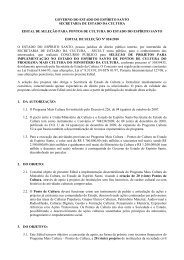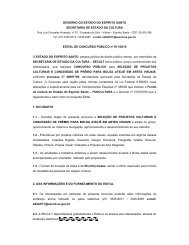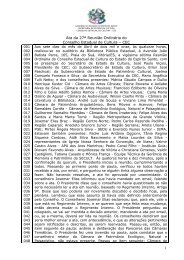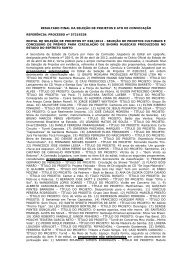Create successful ePaper yourself
Turn your PDF publications into a flip-book with our unique Google optimized e-Paper software.
PIOS / WHISTLES<br />
15 - gutural inspirando / guttural inhalation<br />
31 - tipo tambor / drum type<br />
JAÓ<br />
Crypturellus und. undulatus<br />
Udulated tinamou (USA); Perduz ondulada (Argentina); Gallineta ondulada<br />
(Venezuela)<br />
Ave da ordem dos Tinamiformes, da família Tinamidae. Espécie comum no Brasil<br />
central e em grande parte da Amazônia, da região norte ao centro-oeste – até São<br />
Paulo – , Minas Gerais e Paraná. Durante a primavera forma bandos em que há um<br />
só macho <strong>para</strong> várias fêmeas. Habita local de clima quente, nas regiões sudeste,<br />
nordeste e centro-oeste, principalmente em vegetações ralas, cerrado, capoeirões<br />
e matas de tabuleiro. Seu canto varia de uma região <strong>para</strong> outra. Seu piado<br />
se ouve a grandes distâncias, porém suave. Dizem os mateiros que quando essa<br />
espécie canta, emite um piado trissilábico que alude à pergunta: “eu-sou-jaó?”.<br />
Tamanho: 31cm.<br />
Bird of the Tinamidae family. A common species in central Brazil and in a large part of<br />
the Amazonas region, and from the north of Brazil to the Midwest, as far as São Paulo,<br />
Minas Gerais and Paraná. During the spring it forms groups where there is only one<br />
male for several females. It inhabits warm climates, such as the southeast, northeast<br />
and midwest of the country, particularly in thin vegetation, savannahs, brush woods<br />
and plateaus. Its voice varies from one area to another. Its peep is heard at great distances,<br />
but it is soft. Locals say that when this species sings, it issues a tri-syllabic peep that<br />
asks: “Am-I-jaó?.” (“eu-sou-jaó?”). Size: 31cm.<br />
PIO / WHISTLE 13<br />
ZABELÊ<br />
Crypturellus noctivagus<br />
Yellow-legged Tinamou (USA)<br />
A maior espécie do gênero. Ave da ordem dos Tinamiformes, da família Tinamidae.<br />
Espécie comum no Brasil encontrada em regiões que compreendem o sul da Bahia,<br />
o Espírito Santo, Minas Gerais (Alto Rio Doce), Rio de Janeiro, sendo observadas até<br />
no Rio Grande do Sul. Na região do norte mineiro ao Piauí, Pernambuco e matas<br />
úmidas do noroeste baiano. Habitam locais de clima variado, preferencialmente locais<br />
mais úmidos. Seu piado é melancólico baixo, grave, porém profundo, variando<br />
entre três a quatro sílabas, sendo a primeira forte e longa descendente e as outras<br />
sem flexão. Nos meses de agosto a novembro, várias fêmeas se agrupam em torno<br />
do macho, o que facilita a distinção pelo seu piado baixo, fraco e muito variado.<br />
Tamanho: 35cm.<br />
The largest species of the genre. Bird of the Tinamidae family. A common species in Brazil,<br />
found in areas that comprise the south of Bahia, Espírito Santo, Minas Gerais (Upper Rio<br />
Doce), and Rio de Janeiro, being found as far as Rio Grande do Sul, and also in the area<br />
from the north of Minas to Piauí, Pernambuco and the rain forests of northwestern Bahia.<br />
They inhabit varied climates, preferably humid places. Its voice is a melancholic low peep,<br />
deep, varying from three to four syllables, first long and strong, and then descending, and<br />
the last ones without flexing. From August to November, several females gather around<br />
a male, facilitating identification due to the low, weak and varied peep. Size: 35cm.


